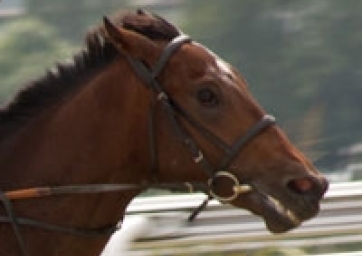
1 January 2017
February 14, 2008 VETERINARY
Oxygen is the fuel of life and its efficient use is the key to athletic fitness. The respiratory system of the racehorse must work hard to harvest the 20 percent of oxygen present in the air we all breathe. Observing a horse after his work on a cold morning provides a visual reminder of this, as the breath surges from his nostrils.
Glucose and oxygen interact via a process called aerobic respiration, resulting in the production of energy. This cellular process powers all of our bodily functions, from breathing and digesting food to sprinting for the winning line. Carbon dioxide and water are by-products of this reaction.
Cells can also produce energy in the absence of oxygen (anaerobic respiration). In this case, glucose is also broken down to release energy. However, the lactic acid formed by this reaction is a more noxious compound than the carbon dioxide and water created by aerobic respiration. Its presence in cells results in muscle cramps and fatigue. This lactic acid must be broken down into carbon dioxide and water, but this reaction again requires oxygen. Essentially, anaerobic respiration allows muscles and other cells to function for a short time in the absence of oxygen, building up an ‘oxygen debt.' This must be repaid later to allow the lactic acid to be broken down.
A good measure of a horse's fitness is how quickly breathing and pulse return to normal after exercise. This is because aerobic respiration is more efficient in fit horses, so they build up less of an oxygen debt while exercising. Less oxygen is required to breakdown lactic acid once the work has been completed.
Oxygen is delivered to the body tissues via the respiratory and cardiovascular systems. The respiratory system of the horse includes everything from the nostrils to the lungs. Air is delivered to the lungs, where oxygen diffuses into the bloodstream and is taken up by red blood cells. These cells are the body's carriers for molecules of oxygen and they are pumped around the body by the heart through arteries, capillaries and veins.
Physical causes of inefficient oxygen delivery
Trainers and veterinary surgeons must make sure that all of the components of the respiratory and cardiovascular systems are working to their full potential. This ensures that the body delivers oxygen as efficiently as possible to the muscles, in order that they have the energy necessary to win races!
A number of medical conditions may also affect the amount of oxygen available to the horse.
Exercise-induced pulmonary hemorrhage (EIPH, or ‘bleeder') is a relatively common condition in which a blood vessel within the lungs bursts, and bleeds into the airways. The severity and amount of blood associated with such an incident can vary markedly. Sometimes relatively large volumes of blood are seen escaping from the horse's nostrils. In other cases, the volume of blood is relatively small and remains confined to the distal airways. This can only be detected after the event by endoscopy and examination of the cell types within the horse's respiratory secretions. Either way, blood takes the place of air within the airways and less oxygen is available to diffuse into the bloodstream. In addition, blood within the airways is a good medium to support bacterial growth and this may predispose horses to bacterial respiratory infections.
The exact cause of EIPH has yet to be elucidated. It may be due to increased blood pressure within the lungs during exercise, concussive damage to the blood vessels as the horse gallops, or a combination of both. Some horses appear to be more prone to this condition than others, and it appears that concurrent respiratory tract infections may also predispose horses to a pulmonary bleed.
Respiratory tract infections may also interfere with optimal oxygenation of the blood. Firstly, infections are associated with an increase in the amount of mucus within the respiratory tract, which may form a physical barrier to airflow and diffusion of oxygen. It is possible to vaccinate against the well-known respiratory viruses, such as influenza and herpes, and some racing authorities require proof of vaccination before a horse can race. However, every horseman will be aware of the non-specific ‘virus,' which results in coughing horses performing at levels below their potential. Viruses may also sensitize the airways, leaving horses more prone to secondary bacterial infections, or post-viral coughs. In addition, it is not uncommon for horses to become anemic following a viral infection. The reduced numbers of circulating red blood cells will lead to sub-optimal oxygen delivery.
A number of supplements are available which aim to enable the horses to manufacture more red blood cells.
The importance of good stable hygiene and maintenance of a dust-free environment should not be understated in hastening recovery from airway infections. Even a healthy racehorse should only be exposed to quality roughage feed (good hay or haylage, etc.) and dust-free bedding material.
The act of breathing is fundamental to animal life and so optimal uptake and use of oxygen is the foundation upon which equine training regimes are based. The horse's respiratory system must be fine-tuned to perform to its full potential and the skilled trainer must make himself aware of any problem which may be impeding this.
Barry Sangster (14 February 2008 - Issue 7)
A natural bronchial dilator. Minimizes mucus build-up during intense exercise. Expectorant (gets rid of mucus). Goes much deeper than nasal devices. Reduces pressure in the respiratory system.
World leading technically advanced iron and multi vitamin supplement.
A high dose liquid iron supplement. Economical and Effective. Compare the ingredients - you won't be disappointed.